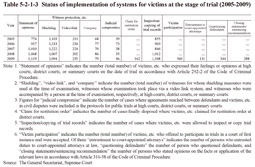2 Victim participation, etc. at trials
(1) Victim participation system, etc.
From 2000 courts have been providing victims, etc. with the opportunity, in principle, to express on the date of the trial if they wish to do so, to express their feelings on the damage caused by the pertinent offense and their opinions with regard to the case.
In addition, the Code of Criminal Procedure was amended (by Act No. 95 of 2007) and the victim participation system started in December 2008. Under this system the court decides whether the victims, etc. of certain offenses can attend the court on the trial date to state their opinions on the performance of public prosecutors, examine witnesses regarding circumstantial issues, question defendants to prepare for expressing their feelings, and state their opinions on fact finding and the application of the relevant laws, etc. In addition, the Act on Measures Incidental to Criminal Procedures for Purpose of Protection of Rights and Interests of Crime Victims (Act No. 75 of 2000) and the Comprehensive Legal Support Act (Act No. 74 of 2004) enable victims, etc., depending on their financial status, to apply for court-appointed attorneys at law to act on their behalf when they participate in criminal proceedings.
Table 5-2-1-3 shows the status of implementation of the above mentioned systems over the last five years.
(2) Witness protection, etc.
The victims of crime often appear as witnesses at trials. There are various systems in place to protect witnesses at the time of examination that include the following: a system of measures to shield the witness from the defendant or from the public at the court; a system in which the witness remains in a different room and is examined via audiovisual communication through the transmission of images and sound (video-link system); and a system that allows a witness to be accompanied by a person whom the court deems appropriate.
Table 5-2-1-3 shows the status of implementation of the above mentioned systems over the last five years.
In addition, a system wherein the victims' identity information, including their names, are protected in criminal proceedings has also been implemented since December 2007, which was used for 3,849 persons in 2009 (Source: The General Secretariat, Supreme Court).
(3) Judicial compromise and restitution order system
The defendants and victims, etc. involved in criminal cases can jointly request when reached an agreement in a civil dispute related to the criminal case the fact to be included in the public trial protocol of the criminal case. Any such agreement included within the protocol has the same effect as a compromise reached in a civil trial (judicial compromise). Victims, etc. can request the pertinent court for the compulsory execution using the protocol of the criminal case if the defendant fails to fulfill their agreed duties.
In addition, for certain serious offenses, the restitution order system has been set forth since December 2008 to enable victims, etc. to claim the pertinent criminal court for restitution order and on the claim the court proceeds exceptional trial procedures to examine the criminal records after the conviction of the criminal case and decides on the claim.
Table 5-2-1-3 shows the status of implementation of the above mentioned systems over the last five years.
(4) Inspection/copying of trial records
Conventionally inspections or copying of trial records has only been permitted upon the request of a victim, etc. when a court has found sufficient reason and grounds for granting any such request. The scope of the applicable cases, however, was extended in December 2007, in that, in principle, courts should now allow victims, etc. to inspect or copy all trial records (victims, etc. of other offenses of similar kinds committed by the same defendant are also allowed to inspect or copy the records if the court deems it necessary and appropriate in exercising their right to claim compensation for damage).
Table 5-2-1-3 shows the number of cases in which victims, etc. inspected/copied trial records over the last five years.
Records of non-prosecuted cases, in principle, cannot be disclosed. However, there are cases where victims, etc. require objective evidence such as on-the-spot investigation report in exercising their right to claim compensation for damage or other rights in civil lawsuits. In light of this, public prosecutors enable such evidence to be inspected or copied if they deem it appropriate, to the extent that it does not to impose any risk of invading the privacy of the persons concerned. In addition, since December 2008, victims, etc. have in principle been allowed to inspect objective evidence in the records of non-prosecuted cases that should have been subject to the victim participation system if it had been indicted, even if the aim is to “identify the details of the case.”
Table 5-2-1-3 Status of implementation of systems for victims at the stage of trial (2005-2009)
